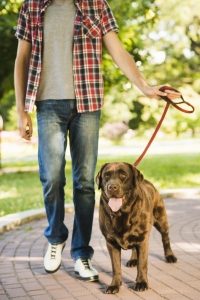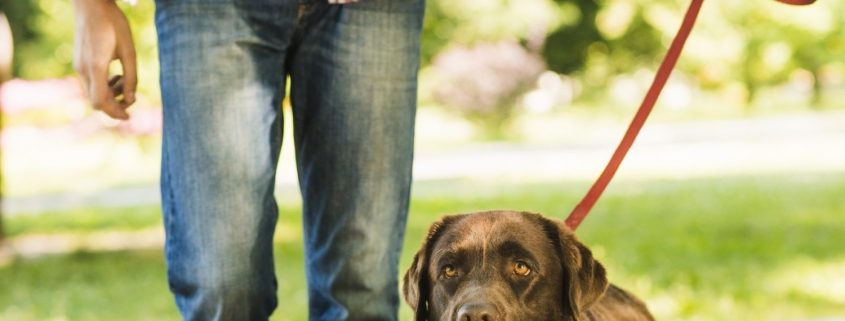Ask Crystal: Dog Reacts on Walks with Barking
Welcome to “Ask Crystal,” where you can ask your pet behavior questions! You can submit your question for Crystal at the bottom of the page!
Dear Crystal,
My dog goes crazy barking when we take him for walks in the neighborhood and he sees other dogs. I tried to make him sit off to the side and stay while dogs walk by but he won’t listen to me. I feel like my neighbors think I am the lady with the crazy, aggressive dog. I am scared he is going to get off the leash and attack another dog. What can I do to fix this behavior?
Sincerely,
Reactive Rover
Dear Reactive,
I can sympathize with your struggles on this one. My dog who is now 14 years old and finally is no longer reactive was very barky at other dogs on walks. I can understand your fears and concerns about your dog being aggressive to other dogs. There is a difference between being reactive and being aggressive. My reactive dog has space issues but is not dog aggressive. She just needs to know that the other dog respects her space. On the flip side, I did have a dog that was dog aggressive and not reactive on leash. I don’t know your dog so I can’t say whether he is or not but I wouldn’t assume that he is based on his reactivity. Now that doesn’t mean I think you should walk him up to other dogs to test it out but there are safe ways with professional dog trainers or dog daycare to test him with other dogs.
 There are a lot of reasons why a dog may start to display dog reactivity. A leash restricts the dog’s ability to flee if he feels frightened. Dogs can feel the constraint of the leash and their inability to get away. If an owner constantly has the leash tightened up, it can really make the dog feel tense. For these reasons, I would really not suggest forcing the dog to sit and stay in these type of situations. He is going to end up feeling like a sitting duck. The way in which dogs greet can affect leash reactivity as well. A polite dog greeting is in an arc. The dogs circle each other and sniff rear ends. If dogs meet up face to face as they often do on leash that can be perceived as rude or threatening. A dog walking directly up to another dog as they often are doing at parks or sidewalks can also be perceived as a threat. As I mentioned with my dog, dogs have different personal space requirements. A well socialized dog’s personal space is about 6 feet, if another dog enters that personal space that may be threatening as well. All the situations that we set our dogs up in can really make them feel uncomfortable. Another reason that a dog may be reactive because he is feeling frustrated at not being able to reach a dog to play. I think more people assume that is the motivation where more often than not it is a fear- based reaction.
There are a lot of reasons why a dog may start to display dog reactivity. A leash restricts the dog’s ability to flee if he feels frightened. Dogs can feel the constraint of the leash and their inability to get away. If an owner constantly has the leash tightened up, it can really make the dog feel tense. For these reasons, I would really not suggest forcing the dog to sit and stay in these type of situations. He is going to end up feeling like a sitting duck. The way in which dogs greet can affect leash reactivity as well. A polite dog greeting is in an arc. The dogs circle each other and sniff rear ends. If dogs meet up face to face as they often do on leash that can be perceived as rude or threatening. A dog walking directly up to another dog as they often are doing at parks or sidewalks can also be perceived as a threat. As I mentioned with my dog, dogs have different personal space requirements. A well socialized dog’s personal space is about 6 feet, if another dog enters that personal space that may be threatening as well. All the situations that we set our dogs up in can really make them feel uncomfortable. Another reason that a dog may be reactive because he is feeling frustrated at not being able to reach a dog to play. I think more people assume that is the motivation where more often than not it is a fear- based reaction.
The first approach in any behavior modification program is to manage the dog and their environment to prevent them from practicing the behavior. The more a dog practices a behavior the stronger that behavior will become. Don’t wait until your dog reacts to something. You have to be alert to your environment and prepared to respond quickly. I find that it is really helpful to walk during off times. I notice more people out walking before and after work hours. It may differ in your neighborhood but if you pay attention you will notice less busy times for dog walking. Or opt for walks outside of the neighborhood near shopping centers or my personal favorite is to walk at schools after hours. If you can find places to walk where there aren’t likely to be other dogs it will be a lot less stressful for both you and your dog. When I did walk in my neighborhood, you might see me duck behind cars or bushes to prevent my dog from seeing another dog. I would often change the direction of my walk to avoid walking near another dog. There are a number of fun cues to teach the dog to get them moving in another direction without it being scary. I like to teach the Emergency U-Turn so that when you need to get out of dodge you can do it in an upbeat way. I also like to teach distraction techniques like “Find It” to occupy the dog as the other dog moves by. I used this with my dog on hikes where the distance was too close. She wouldn’t even realize the other dog was walking by.
There are a lot of different ways to work on reactivity and what works for someone else may not work for your dog. However, no matter what training method you use, the first thing you will need to do is figure out what their threshold is. The threshold is the distance at what your dog can see its trigger and not react. Depending on your dog that may be 10 feet or 100 feet. You have to carefully watch your dog and the environment to figure out what the threshold is for them. It may be different on different days depending on what else has been happening for them. You may need to start training in the parking lot of a park or pet supply store so that you can get far enough away from triggers. If the motivation is fear, you may want to reinforce the dog for looking away from the other dog. I usually start this by reinforcing with a yes and treat for looking at the dog and not reacting. What starts to happen after a while is the dog will see the other dog and look back at you. When that starts to happen, move your criteria to waiting for the dog to look at you before marking and rewarding. Throughout your training you will need to slowly decrease the distance between your dog and the trigger. If your dog starts reacting, you moved too fast and need to step back to where they are not reacting. The dog cannot think or learn when it is in an emotional state so we need to get them back into their thinking brain. Another method you can try is, when mark and reward with a treat and then move away from the trigger. What better reinforcement for a dog that is fearful to get to move away from the trigger. The treats should be flowing while the trigger is in sight and stop when it leaves or you move away.
Training a dog with dog with dog reactivity can be a challenging feat. You will feel like you are moving forward some days and backwards the next. Changing behavior is never in a straight line. It is the same for us when we try to change our own behavior. We will have days that we slip up. I like to think of the neural pathways that control behavior like a jungle path. You machete your way through the path and walk it every day so that it becomes smooth and easy to traverse. You don’t even have to think about it anymore, you just follow it. When we are trying to form a new neuron pathway, we must ask ourselves or our dogs to take an unbeaten path over the smooth and easy. In order for them to make that choice, we have to make it really appealing to choose the difficult path. So be patient with your dog and yourself. It is a marathon not a sprint.
Until next time,
Crystal







